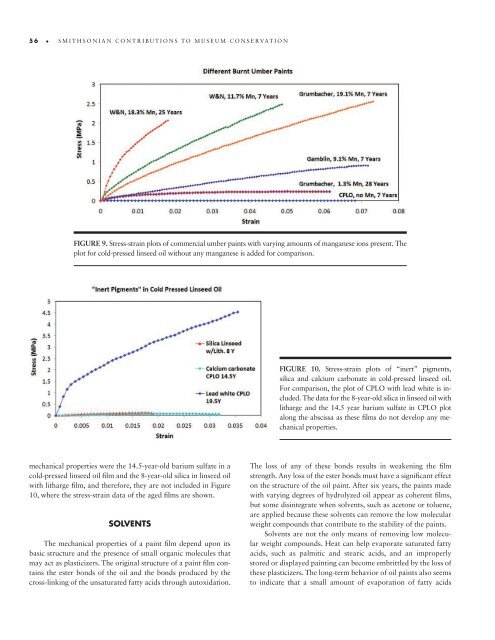You also want an ePaper? Increase the reach of your titles
YUMPU automatically turns print PDFs into web optimized ePapers that Google loves.
56 • smithsonian contributions to museum conservation<br />
FIGURE 9. Stress-strain plots <strong>of</strong> commercial umber paints with varying amounts <strong>of</strong> manganese ions present. The<br />
plot for cold-pressed linseed oil without any manganese is added for comparison.<br />
FIGURE 10. Stress-strain plots <strong>of</strong> “inert” pigments,<br />
silica and calcium carbonate in cold-pressed linseed oil.<br />
For comparison, <strong>the</strong> plot <strong>of</strong> CPLO with lead white is included.<br />
The data for <strong>the</strong> 8-year-old silica in linseed oil with<br />
litharge and <strong>the</strong> 14.5 year barium sulfate in CPLO plot<br />
along <strong>the</strong> abscissa as <strong>the</strong>se films do not develop any mechanical<br />
properties.<br />
mechanical properties were <strong>the</strong> 14.5-year-old barium sulfate in a<br />
cold-pressed linseed oil film and <strong>the</strong> 8-year-old silica in linseed oil<br />
with litharge film, and <strong>the</strong>refore, <strong>the</strong>y are not included in Figure<br />
10, where <strong>the</strong> stress-strain data <strong>of</strong> <strong>the</strong> aged films are shown.<br />
SOLVENTS<br />
The mechanical properties <strong>of</strong> a paint film depend upon its<br />
basic structure and <strong>the</strong> presence <strong>of</strong> small organic molecules that<br />
may act as plasticizers. The original structure <strong>of</strong> a paint film contains<br />
<strong>the</strong> ester bonds <strong>of</strong> <strong>the</strong> oil and <strong>the</strong> bonds produced by <strong>the</strong><br />
cross-linking <strong>of</strong> <strong>the</strong> unsaturated fatty acids through autoxidation.<br />
The loss <strong>of</strong> any <strong>of</strong> <strong>the</strong>se bonds results in weakening <strong>the</strong> film<br />
strength. Any loss <strong>of</strong> <strong>the</strong> ester bonds must have a significant effect<br />
on <strong>the</strong> structure <strong>of</strong> <strong>the</strong> oil paint. After six years, <strong>the</strong> paints made<br />
with varying degrees <strong>of</strong> hydrolyzed oil appear as coherent films,<br />
but some disintegrate when solvents, such as acetone or toluene,<br />
are applied because <strong>the</strong>se solvents can remove <strong>the</strong> low molecular<br />
weight compounds that contribute to <strong>the</strong> stability <strong>of</strong> <strong>the</strong> paints.<br />
Solvents are not <strong>the</strong> only means <strong>of</strong> removing low molecular<br />
weight compounds. Heat can help evaporate saturated fatty<br />
acids, such as palmitic and stearic acids, and an improperly<br />
stored or displayed painting can become embrittled by <strong>the</strong> loss <strong>of</strong><br />
<strong>the</strong>se plasticizers. The long-term behavior <strong>of</strong> oil paints also seems<br />
to indicate that a small amount <strong>of</strong> evaporation <strong>of</strong> fatty acids
















